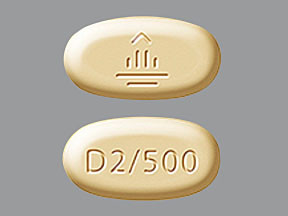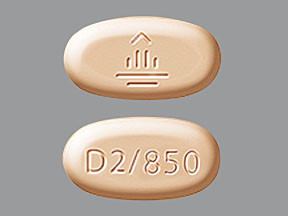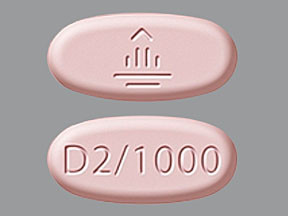LINAGLIPTIN/METFORMIN - ORAL
PHONETIC PRONUNCIATION: (LIN-a-GLIP-tin/met-FOR-min)
COMMON BRAND NAME(S): Jentadueto
GENERIC NAME(S): linagliptin/metformin HCl
Uses
USES: Linagliptin/metformin is used with a proper diet and exercise program to control high blood sugar in people with type 2 diabetes. Controlling high blood sugar helps prevent kidney damage, blindness, nerve problems, loss of limbs, and sexual function problems. Proper control of diabetes may also lessen your risk of a heart attack or stroke. This product contains 2 medications: linagliptin and metformin. Linagliptin works by increasing levels of natural substances called incretins. Incretins help to control blood sugar by increasing insulin release, especially after a meal. They also decrease the amount of sugar your liver makes. Metformin works by helping to restore your body's proper response to the insulin you naturally produce. It also decreases the amount of sugar that your liver makes and that your stomach/intestines absorb.
How to use LINAGLIPTIN/METFORMIN - ORAL
HOW TO USE: Read the Medication Guide and, if available, the Patient Information Leaflet provided by your pharmacist before you start taking linagliptin/metformin and each time you get a refill. If you have any questions, ask your doctor or pharmacist. Take this medication by mouth as directed by your doctor, usually twice daily with meals. Drink plenty of fluids while taking this medication unless otherwise directed by your doctor. The dosage is based on your medical condition, response to treatment, and other medications you may be taking. Be sure to tell your doctor and pharmacist about all the products you use (including prescription drugs, nonprescription drugs, and herbal products). To reduce your risk of side effects (such as upset stomach), your doctor may direct you to start this medication at a low dose and gradually increase your dose. Follow your doctor's instructions carefully. Take this medication regularly to get the most benefit from it. To help you remember, take it at the same times each day. Carefully follow the medication treatment plan, meal plan, and exercise program your doctor has recommended. Tell your doctor if your condition does not improve or if it worsens (your blood sugar is too high or too low).
Side Effects
Precautions
Interactions
Overdose
Images

- color
- light yellow
- shape
- oblong
- imprint
- D2/500, logo

- color
- light yellow
- shape
- oblong
- imprint
- D2/500, logo

- color
- light orange
- shape
- oblong
- imprint
- D2/850, logo

- color
- light orange
- shape
- oblong
- imprint
- D2/850, logo

- color
- light pink
- shape
- oblong
- imprint
- D2/1000, logo

- color
- light pink
- shape
- oblong
- imprint
- D2/1000, logo
Reviews
Faq for LINAGLIPTIN/METFORMIN - ORAL
Linagliptin/metformin is an oral medication that combines two different drugs, linagliptin and metformin, to help control blood sugar levels in people with type 2 diabetes. Linagliptin belongs to a class of drugs called DPP-4 inhibitors, which help regulate blood sugar levels by increasing the release of insulin and decreasing the production of glucose by the liver. Metformin is a biguanide drug that lowers blood sugar levels by reducing the amount of glucose produced in the liver and improving the body's response to insulin.
Linagliptin/metformin is used to manage blood sugar levels in people with type 2 diabetes. It is typically prescribed as part of a comprehensive treatment plan that includes a healthy diet and regular exercise. It is not intended for the treatment of type 1 diabetes.
Common side effects of linagliptin/metformin may include diarrhea, stomach upset, nausea, vomiting, metallic taste in the mouth, headache, dizziness, or weakness. These side effects usually subside over time. However, if they persist or worsen, it is important to notify your healthcare provider.
Patients with kidney problems, liver disease, heart failure, or a history of lactic acidosis should exercise caution while taking linagliptin/metformin. It is important to inform your doctor about any medical conditions or medications you are currently taking before starting this medication. Additionally, linagliptin/metformin may cause low blood sugar levels (hypoglycemia), so it is important to monitor your blood sugar regularly and be aware of the signs and symptoms of hypoglycemia.
Linagliptin/metformin is typically taken with meals to reduce gastrointestinal side effects. The dosing will be determined by your healthcare provider based on your individual needs and response to the medication. It is important to take the medication as directed and not to exceed the recommended dosage.
Linagliptin/metformin may interact with certain medications, so it is important to inform your healthcare provider about all the medications you are currently taking, including over-the-counter drugs and herbal supplements. Some medications may increase the risk of lactic acidosis, a serious condition that can occur with the use of metformin, so it is important to discuss your medication list with your doctor.
Linagliptin/metformin may start working within a few days to a week of starting the medication. However, it may take several weeks to see the full effects on blood sugar control. It is important to continue taking the medication as prescribed and regularly monitor your blood sugar levels.
It is important to consult with your healthcare provider before taking linagliptin/metformin if you are pregnant or planning to become pregnant. This medication is not recommended during breastfeeding as it is unknown if it passes into breast milk.
Linagliptin/metformin should not be stopped suddenly without consulting a healthcare provider. Abruptly discontinuing the medication may cause a sudden increase in blood sugar levels. It is essential to discuss any changes in medication regimen with your doctor.
Warning
WARNING: Rarely, too much metformin can build up in the body and cause a serious (sometimes fatal) condition called lactic acidosis. Lactic acidosis is more likely if you are an older adult, if you have kidney or liver disease, dehydration, heart failure, heavy alcohol use, if you have surgery, if you have X-ray or scanning procedures that use iodinated contrast, or if you are using certain drugs. For some conditions, your doctor may tell you to stop taking this medication for a short time. Ask your doctor or pharmacist for more details. Stop taking this medication and get medical help right away if you have any symptoms of lactic acidosis, such as unusual tiredness, dizziness, severe drowsiness, chills, blue/cold skin, muscle pain, fast/difficult breathing, slow/irregular heartbeat, or stomach pain with nausea/vomiting/diarrhea.
Disclaimer
IMPORTANT: HOW TO USE THIS INFORMATION: This is a summary and does NOT have all possible information about this product. This information does not assure that this product is safe, effective, or appropriate for you. This information is not individual medical advice and does not substitute for the advice of your health care professional. Always ask your health care professional for complete information about this product and your specific health needs.
No Reviews Yet